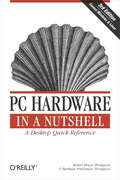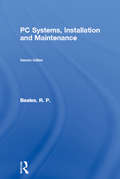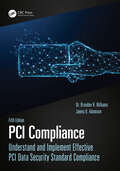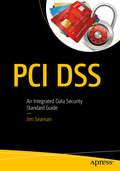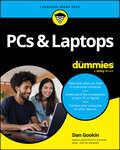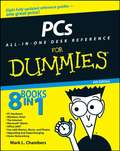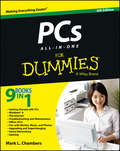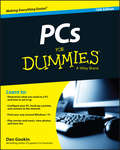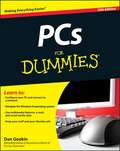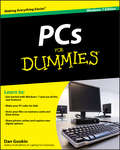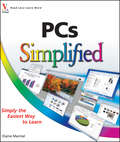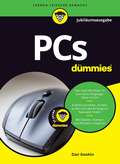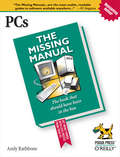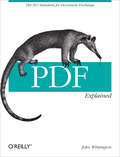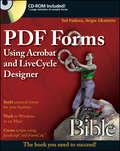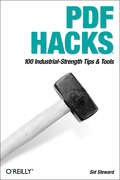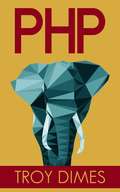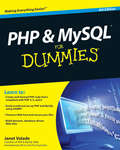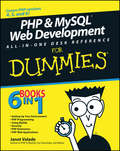- Table View
- List View
PC Hardware in a Nutshell: A Desktop Quick Reference
by Robert Bruce Thompson Barbara Fritchman ThompsonPC Hardware in a Nutshell is the practical guide to buying, building, upgrading, and repairing Intel-based PCs. A longtime favorite among PC users, the third edition of the book now contains useful information for people running either Windows or Linux operating systems. Written for novices and seasoned professionals alike, the book is packed with useful and unbiased information, including how-to advice for specific components, ample reference material, and a comprehensive case study on building a PC.In addition to coverage of the fundamentals and general tips about working on PCs, the book includes chapters focusing on motherboards, processors, memory, floppies, hard drives, optical drives, tape devices, video devices, input devices, audio components, communications, power supplies, and maintenance. Special emphasis is given to upgrading and troubleshooting existing equipment so you can get the most from your existing investments.This new edition is expanded to include:Detailed information about the latest motherboards and chipsets from AMD, Intel, SiS, and VIAExtensive coverage of the Pentium 4 and the latest AMD processors, including the Athlon XP/MPFull details about new hard drive standards, including the latest SCSI standards, ATA/133, Serial ATA, and the new 48-bit "Big Drive" ATA interfaceExtended coverage of DVD drives, including DVD-RAM, DVD-R/RW, and DVD+R/RWDetails about Flat Panel Displays, including how to choose one (and why you might not want to)New chapters on serial communications, parallel communications, and USB communications (including USB 2.0)Enhanced troubleshooting coveragePC Hardware in a Nutshell, 3rd Edition provides independent, useful and practical information in a no-nonsense manner with specific recommendations on components. Based on real-world testing over time, it will help you make intelligent, informed decisions about buying, building, upgrading, and repairing PCs in a cost effective manner that will help you maximize new or existing computer hardware systems. It's loaded with real-world advice presented in a concise style that clearly delivers just the information you want, without your having to hunt for it.
PC Pest Control
by Preston GrallaThe Internet is rife with all kinds of creepy PC bugs. In the first six months of 2004, almost 5,000 new Windows viruses and worms were discovered that were capable of compromising computer security. But the pests that users deal with aren't limited to viruses. They're plagued with everything from spam to phishing. But just because your computer is hooked up to the Internet doesn't mean your PC has to be at risk. In a constant battle of one-upmanship, the forces of good have devised a number of creative ways to fend off these Internet nasties in order to best protect your computer. And PC Pest Control from O'Reilly spells out how you can do just that. Written in a friendly, engaging manner, this handy guide covers detection, prevention and cure, where you're vulnerable, and how to surf the web more safely. It also details how you can protect yourself against adware, spyware, home page hijackers, viruses, Trojans, spam, phishing attacks, and more. For easy understanding, PC Pest Control describes each problem and its symptoms, rates the danger level, and then shows you how to solve the problem step by step. In addition, a supporting website keeps the book's content as up to date as possible, so you're always informed of the latest safeguards. And in a field that shifts as frequently as PC protection, that's a major advantage. So if you want to make sure that your personal computer doesn't fall victim to attack-or if your system has already been infected and you want to start anew-then PC Pest Control is most definitely for you.
PC Systems, Installation and Maintenance
by R. P. BealesWritten in a straightforward, easy to read style, Rob Beales provides the knowledge and techniques needed to build, troubleshoot, and maintain personal computer systems.Divided into three parts, Part 1 forms an introduction to digital computers, leading the reader through the various parts of a modern PC system, including popular peripherals and networking concepts. Part 2 contains a step-by-step guide on the assembly and configuration of a complete state-of-the-art PC system, including a section on the use of important Windows 98 / ME / 2000 / XP applications and components. Part 3 covers preventative, predictive and corrective maintenance, based in typical current work practice – a major part of the IT practitioner’s work schedule.Case Studies and practical worked examples are included throughout the text, with additional Case Studies, specifically aimed to meet the requirements of e-Quals courses on an accompanying website. Further web resources include key figures from the text available to download in full-colour, with a wealth of extra material covering Binary / Hex and basic logic functions; ASCII tables; Connector types and pinouts; Bus slots; RAM slots and further useful website links.Updated throughout in line with current technologies, the second edition is also designed to cover the latest specifications of BTEC National and City and Guilds e-Quals (400 and 500) courses, and the A+ certification, in addition to meeting the needs of the general PC user.
PCI Compliance: The Definitive Guide
by Abhay BhargavAlthough organizations that store, process, or transmit cardholder information are required to comply with payment card industry standards, most find it extremely challenging to comply with and meet the requirements of these technically rigorous standards. PCI Compliance: The Definitive Guide explains the ins and outs of the payment card industry (
PCI Compliance: Understand and Implement Effective PCI Data Security Standard Compliance
by Branden R Williams James AdamsonThe Payment Card Industry Data Security Standard (PCI DSS) is now in its 18th year, and it is continuing to dominate corporate security budgets and resources. If you accept, process, transmit, or store payment card data branded by Visa, MasterCard, American Express, Discover, or JCB (or their affiliates and partners), you must comply with this lengthy standard. Personal data theft is at the top of the list of likely cybercrimes that modern-day corporations must defend against. In particular, credit or debit card data is preferred by cybercriminals as they can find ways to monetize it quickly from anywhere in the world. Is your payment processing secure and compliant? The new Fifth Edition of PCI Compliance has been revised to follow the new PCI DSS version 4.0, which is a complete overhaul to the standard. Also new to the Fifth Edition are: additional case studies and clear guidelines and instructions for maintaining PCI compliance globally, including coverage of technologies such as Kubernetes, cloud, near-field communication, point-to-point encryption, Mobile, Europay, MasterCard, and Visa. This is the first book to address the recent updates to PCI DSS and the only book you will need during your PCI DSS journey. The real-world scenarios and hands-on guidance will be extremely valuable, as well as the community of professionals you will join after buying this book. Each chapter has how-to guidance to walk you through implementing concepts and real-world scenarios to help you grasp how PCI DSS will affect your daily operations. This book provides the information that you need in order to understand the current PCI Data Security Standards and the ecosystem that surrounds them, how to effectively implement security on network infrastructure in order to be compliant with the credit card industry guidelines, and help you protect sensitive and personally identifiable information. Our book puts security first as a way to enable compliance. Completely updated to follow the current PCI DSS version 4.0 Packed with tips to develop and implement an effective PCI DSS and cybersecurity strategy Includes coverage of new and emerging technologies such as Kubernetes, mobility, and 3D Secure 2.0 Both authors have broad information security backgrounds, including extensive PCI DSS experience
PCI DSS: An Integrated Data Security Standard Guide
by Jim SeamanGain a broad understanding of how PCI DSS is structured and obtain a high-level view of the contents and context of each of the 12 top-level requirements. The guidance provided in this book will help you effectively apply PCI DSS in your business environments, enhance your payment card defensive posture, and reduce the opportunities for criminals to compromise your network or steal sensitive data assets. Businesses are seeing an increased volume of data breaches, where an opportunist attacker from outside the business or a disaffected employee successfully exploits poor company practices. Rather than being a regurgitation of the PCI DSS controls, this book aims to help you balance the needs of running your business with the value of implementing PCI DSS for the protection of consumer payment card data.Applying lessons learned from history, military experiences (including multiple deployments into hostile areas), numerous PCI QSA assignments, and corporate cybersecurity and InfoSec roles, author Jim Seaman helps you understand the complexities of the payment card industry data security standard as you protect cardholder data. You will learn how to align the standard with your business IT systems or operations that store, process, and/or transmit sensitive data. This book will help you develop a business cybersecurity and InfoSec strategy through the correct interpretation, implementation, and maintenance of PCI DSS. What You Will Learn Be aware of recent data privacy regulatory changes and the release of PCI DSS v4.0Improve the defense of consumer payment card data to safeguard the reputation of your business and make it more difficult for criminals to breach securityBe familiar with the goals and requirements related to the structure and interdependencies of PCI DSSKnow the potential avenues of attack associated with business payment operationsMake PCI DSS an integral component of your business operationsUnderstand the benefits of enhancing your security cultureSee how the implementation of PCI DSS causes a positive ripple effect across your business Who This Book Is For Business leaders, information security (InfoSec) practitioners, chief information security managers, cybersecurity practitioners, risk managers, IT operations managers, business owners, military enthusiasts, and IT auditors
PCs & Laptops For Dummies
by Dan GookinA one-stop guide to making the most of your desktop PC or laptop computer PCs and Laptops For Dummies is the essential user's guide to the features your PC or laptop has to offer—and how to use them successfully. With this book as your coach, you can jump over technological hurdles with ease, navigating the hardware and software of your personal computer. Regardless of what brand of computer you use, you'll learn to navigate the latest version of Windows. You'll also explore how PCs, laptops, and other mobile devices can be used together, and how to keep your data secure. This Dummies guide is your first step toward computer-whiz status, saving you time and energy with everything in one place. Learn about Microsoft Windows, the operating system for PC and laptop Discover PC and laptop features you never knew about, and get your devices to play nicely together Identify the specs and features you need, so you can purchase a computer that's a fit for you Get easy-to-understand information, advice, and tricks at your fingertips This is the perfect Dummies guide for PC or laptop users at home or at work who need a go-to guide for their hardware and software questions.
PCs All-in-One Desk Reference For Dummies
by Mark L. ChambersNeed the scoop on Windows Vista? How about Office 2007? Anything you need to know about using your PC can probably be found in PCs All-In-One Desk Reference for Dummies, 4th Edition.This handy guide is made up of eight convenient minibooks, so you can find what you need in a hurry. And in case you think you've seen it before, this fourth edition is fully updated for all the newest, coolest stuff. Want a guided tour of the Vista operating system and how it differs from XP? Check out minibook #2. Have you heard about Microsoft Works but aren't sure what it's about? Find out in Book #4. Planning to network all the computers in your home? Minibook #8 is just what you need. The entire repertoire includesPC HardwareWindows VistaThe InternetMicrosoft WorksOffice 2007Fun With Movies, Music, and PhotosUpgrading and SuperchargingHome NetworkingFor all the things you probably do with your PC -- browsing the Internet, e-mail, word processing, presentations, spreadsheets, organizing and sharing digital photos and video, downloading music -- you'll find you can get right to the point and discover what you want to know, quickly and easily. You'll want to keep PCs All-In-One Desk Reference for Dummies, 4th Edition handy, say on your desk, maybe?
PCs All-in-One For Dummies, 6th Edition
by Mark L. ChambersA perfect companion for your PC! Whether you use your PC for work or play, there's a lot to learn and a lot of territory to discover, so take along a good guide. Serving up nine meaty minibooks, this All-in-One guide covers essential PC topics from soup through nuts, including the latest on PC hardware, Windows 8, the Internet, all the tools in Office 2013, digital media, troubleshooting and maintenance, upgrading your PC, home networking, and PC gaming. You'll get to know your PC inside and out and find yourself turning to this terrific resource again and again. This new edition features expanded coverage of home networking and desktop gaming, cool hardware for hardcore gamers, exciting new Windows 8 features, and much more. Nine minibooks provide a comprehensive PC overview and include PC Hardware; Windows 8; The Internet; Troubleshooting and Maintenance; Office 2013; Music, Movies, and Photos; Upgrading and Supercharging; Home Networking; and Gaming Explores step-by-step procedures for using the new Windows 8 operating system Delves into the techy nitty-gritty on things like processor speeds, hard drive capacities, and upgrading Reviews ways to protect your PC from viruses, offers troubleshooting tips, and discusses how to supercharge your PC's performance PCs All-in-One For Dummies, 6th Edition covers everything you need to know to get the most out of your PC.
PCs For Dummies
by Dan GookinThe bestselling PC reference on the planet--now available in its 13th edition Completely updated to cover the latest technology and software, the 13th edition of PCs For Dummies tackles using a computer in friendly, human terms. Focusing on the needs of the beginning computer user, while also targeting those who are familiar with PCs, but need to get up to speed on the latest version of Windows. This hands-on guide takes the dread out of working with a personal computer. Leaving painful jargon and confusing terminology behind, it covers Windows 9 OS, connecting to and using services and data in the cloud, and so much more. Written by Dan Gookin, the original For Dummies author, it tells you how to make a PC purchase, what to look for in a new PC, how to work with the latest operating system, ways to protect your files, what you can do online, media management tips, and even basic topics you're probably too shy to ask a friend about. Determine what you need in a PC and how to set it up Configure your PC, hook up a printer, and connect to the Internet Find your way around Windows 9 OS with ease and confidence Play movies and music, view photos, and explore social media If you're a first-time PC user at home or at work or just need to brush up on the latest technological advancements, the new edition of this bestselling guide gets you up and running fast.
PCs For Dummies 12th Edition
by Dan GookinThe all-time bestselling PC reference, fully updated for the newest technologies! Previous editions of this fun and friendly PC guide have sold more than three million copies, making it the bestselling PC reference in the world. Dan Gookin, the author whose straightforward and entertaining style is the foundation of the For Dummies series, gives you the same easy-to-follow guidance in this edition, fully updated for Windows 8, using the cloud, and all the newest PC bells and whistles. It's perfect for the absolute beginner as well as for anyone switching to the latest hardware and software. Updated with information on all the latest upgrades, this edition of a worldwide bestseller covers all the essentials of using a PC, and presents them in a fun, non-intimidating style Popular technology author Dan Gookin starts at the beginning with all the basics that other books assume everyone knows Covers setting up your PC, exploring the Windows 8 interface, using network hardware and software, getting online and browsing with the newest version of Internet Explorer, setting up an e-mail account, connecting to the cloud, and using cloud-based services Shows you how to install and upgrade programs and manage files and folders Explores working with digital photos, downloading music, watching movies, and participating in social media PCs For Dummies, 12th Edition is the jargon-free, easy-to-use guide to everything you need to know about your PC.
PCs For Dummies Windows 7 Edition
by Dan GookinGet the latest edition of the bestselling PC book on the planet! What better way to make friends with your new PC than with this new edition of the bestselling PC book in the world? PCs For Dummies, Windows 7 Edition explains the latest Windows operating system in a refreshingly jargon-free way that's loaded with good humor and great help. Discover how to make your PC safe for your kids, get in touch with your digital life, use flash drives, learn about green computing, and much more. Dan Gookin, author of the original DOS For Dummies, helped launch the worldwide popularity of the series; his books have been translated in 32 languages and have more than 12 million copies in print This guide gets you up to speed on the latest PC hardware and software and covers all the innovations and changes in Windows 7, all without the boring jargon Covers making your PC safe for kids, organizing your digital life, green computing, storage on memory cards and flash drives, online photo sharing, and much more Make your life easier the Dummies way with PCs For Dummies, Windows 7 Edition.
PCs Simplified
by Elaine MarmelSimply the easiest way to start using a Windows PCIf you want a "show me how, don't tell me why" approach to learning how to use a computer, this is the book for you. Large, full-color screen shots and numbered, step-by-step instructions show you how to get up and running with Windows and the latest hardware add-ons, the Internet, and popular software applications. Learn all the basics plus how to use Office 2010, protect your computer from viruses, sync up mobile devices, and much more.Designed for people who learn best visually, this full-color guide covers basic information for beginning computer users, including how to use Windows 7, multimedia applications, wireless devices, and the InternetUses large screen shots and step-by-step instructions to make learning fast and easyCovers Office 2010, multimedia management, virus protection, popular software applications, common peripherals, and basic securityShows how to integrate the latest wireless technologies and sync mobile devices Visual learners will find this colorful guide shows exactly what to expect at every step and makes learning to use a PC easier than ever before.
PCs für Dummies (Für Dummies)
by Dan GookinDer PC macht nie das, was er soll? Arbeiten am Computer dauern immer viel länger als geplant? Dann sollten Sie dieses Buch lesen. Dan Gookin - Computerexperte der ersten Stunde und Bestseller-Autor - bringt Ihnen geduldig die Tipps und Tricks im Umgang mit dem PC bei. Er spricht von der Maschine als gutem Freund. Fachbegriffe und Technikausdrücke vermeidet er konsequent. Das Buch begleitet Sie vom Auspacken des Computers bis ins Internet. So verlieren Sie schnell die Ehrfurcht vor diesem allgegenwärtigen und im Alltag mittlerweile unverzichtbaren Gerät. Und sind fix auf dem neuesten Stand: Windows 10 und die Cloud werden genauso verständlich behandelt wie der Rest.
PCs für Dummies (Für Dummies)
by Dan GookinDer PC macht nie das, was er soll? Dieses Buch hilft Ihnen dabei, effizient mit Ihrem Computer zu arbeiten. Dan Gookin bringt Ihnen alle wichtigen Grundlagen und viele Tricks im Umgang mit dem PC bei. Er spricht von der Maschine als gutem Freund. Fachbegriffe und Technikausdrücke vermeidet er konsequent. Das Buch begleitet Sie vom Auspacken des Computers bis ins Internet. So legen Sie schnell Berührungsängste vor diesem im Alltag mittlerweile unverzichtbaren Gerät ab und sind fix auf dem neuesten Stand: Windows 11 und die Cloud werden genauso verständlich behandelt wie vieles andere.
PCs: The Missing Manual (Missing Manual)
by David A. Karp Andy RathboneYour vacuum comes with one. Even your blender comes with one. But your PC--something that costs a whole lot more and is likely to be used daily and for tasks of far greater importance and complexity--doesn't come with a printed manual. Thankfully, that's not a problem any longer: PCs: The Missing Manual explains everything you need to know about PCs, both inside and out, and how to keep them running smoothly and working the way you want them to work.A complete PC manual for both beginners and power users, PCs: The Missing Manual has something for everyone. PC novices will appreciate the unassuming, straightforward tutorials on PC basics, such as hooking up a monitor, keyboard, mouse, printer, and scanner. Families will enjoy sections on networking several computers to share an Internet connection, sharing one monitor between two PCs, connecting portable media players, and creating a home theater system. Adventurous PC users will like the clear photos explaining how to take your PC apart and replace or upgrade any failing parts; IT professionals will be grateful to have something to hand to their coworkers who need solid, trusted information about using their PC.In PCs: The Missing Manual, bestselling computer author Andy Rathbone delivers simple, reliable advice on the kinds of things PC users confront every day. He shows you how to connect and configure today's must-have devices (including digital cameras, portable music players, digital camcorders, and keychain drives); burn CDs and DVDs; scan and fax documents, and more. His section on the Internet explains how to choose the best Internet Service Provider and web browser for your needs; send email; find information quickly on the Web; share photos online; set up a blog; set up a webcam; access TV and radio through the Internet; and shop safely online. And Rathbone delivers plenty of guidance on keep your privacy and your PC safe by installing firewalls, creating safe passwords, running antivirus software, removing spyware and adware, and backing up important files.
PDCA/Test
by William LewisMost manuals assume software testing is being performed as part of a well-defined, structured development cycle based on clearly stated requirements and standards. Unfortunately, this is not often the case in the real world. Indeed, the one true constant in software development is change.PDCA/TEST presents a continuous quality framework bas
PDF Explained: The ISO Standard for Document Exchange
by John WhitingtonAt last, here’s an approachable introduction to the widely used Portable Document Format. PDFs are everywhere, both online and in printed form, but few people take advantage of the useful features or grasp the nuances of this format. This concise book provides a hands-on tour of the world’s leading page-description language for programmers, power users, and professionals in the search, electronic publishing, and printing industries. Illustrated with lots of examples, this book is the documentation you need to fully understand PDF.Build a simple PDF file from scratch in a text editor Learn the layout and content of a PDF file, as well as the syntax of its objectsExamine the logical structure of PDF objects, and learn how pages and their resources are arranged into a documentCreate vector graphics and raster images in PDF, and deal with transparency, color spaces, and patternsExplore PDF operators for building and showing text stringsGet up to speed on bookmarks, metadata, hyperlinks, annotations, and file attachmentsLearn how encryption and document permissions work in PDFUse the pdftk program to process PDF files from the command line
PDF Forms Using Acrobat and LiveCycle Designer Bible
by Ted Padova Angie OkamotoThis comprehensive guide to creating fillable forms with the latest release of Adobe Acrobat is packed with real-world insights and techniques gained from daily use of Adobe Acrobat and Adobe LiveCycle Designer under business deadline situations. You'll get step-by-step instructions that show you how to easily create and implement interactive PDF forms using both Adobe Acrobat and Adobe LiveCycle Designer.Note: CD-ROM/DVD and other supplementary materials are not included as part of eBook file.
PDF Hacks: 100 Industrial-Strength Tips & Tools
by Sid StewardPDF--to most of the world it stands for that rather tiresome format used for documents downloaded from the web. Slow to load and slower to print, hopelessly unsearchable, and all but impossible to cut and paste from, the Portable Document Format doesn't inspire much affection in the average user. But PDFs done right is another story. Those who know the ins and outs of this format know that it can be much more than electronic paper. Flexible, compact, interactive, and even searchable, PDF is the ideal way to present content across multiple platforms.PDF Hacks unveils the true promise of Portable Document Format, going way beyond the usual PDF as paged output mechanism. PDF expert Sid Steward draws from his years of analyzing, extending, authoring, and embellishing PDF documents to present 100 clever hacks--tools, tips, quick-and-dirty or not-so-obvious solutions to common problems. PDF Hacks will show you how to create PDF documents that are far more powerful than simple representations of paper pages. The hacks in the book cover the full range of PDF functionality, from the simple to the more complex, including generating, manipulating, annotating, and consuming PDF information. You'll learn how to manage content in PDF, navigate it, and reuse it as necessary. Far more than another guide to Adobe Acrobat, the book covers a variety of readily available tools for generating, deploying, and editing PDF. The little-known tips and tricks in this book are ideal for anyone who works with PDF on a regular basis, including web developers, pre-press users, forms creators, and those who generate PDF for distribution. Whether you want to fine-tune and debug your existing PDF documents or explore the full potential the format offers, PDF Hacks will turn you into a PDF power user.
PEM Fuel Cells with Bio-Ethanol Processor Systems
by Rachid Outbib Diego Feroldi Marta S. BasualdoAn apparently appropriate control scheme for PEM fuel cells may actually lead to an inoperable plant when it is connected to other unit operations in a process with recycle streams and energy integration. PEM Fuel Cells with Bio-Ethanol Processor Systems presents a control system design that provides basic regulation of the hydrogen production process with PEM fuel cells. It then goes on to construct a fault diagnosis system to improve plant safety above this control structure. PEM Fuel Cells with Bio-Ethanol Processor Systems is divided into two parts: the first covers fuel cells and the second discusses plants for hydrogen production from bio-ethanol to feed PEM fuel cells. Both parts give detailed analyses of modeling, simulation, advanced control, and fault diagnosis. They give an extensive, in-depth discussion of the problems that can occur in fuel cell systems and propose a way to control these systems through advanced control algorithms. A significant part of the book is also given over to computer-aided engineering software tools that can be used to evaluate the dynamic performance of the overall plant. PEM Fuel Cells with Bio-Ethanol Processor Systems is intended for use by researchers and advanced students on chemical, electrical-electronic and mechanical engineering courses in which dynamics and control are incorporated with the traditional steady-state coverage of flowsheet synthesis, engineering economics and optimization.
PHP
by Troy Dimes Caroline L.El Preprocesador Hipertexto, comúnmente llamado PHP, es uno de los lenguajes de programación cliente-servidor de códigos abiertos más ampliamente usados. Sitios web famosos incluyendo Facebook, Yahoo, Friendster, WorldPress y Flickr son arrancados por PHP. Este libro proporciona una breve introducción de programación en PHP. En éste, a usted se le enseñarán conceptos importantes de PHP, comenzando con lo básico y moviéndose a un PHP orientado a objetos más avanzados.
PHP
by Troy Dimes Consalvo CattutoPHP è uno dei più diffusi linguaggi di programmazione open source lato server. Volete imparare a programmare in PHP e volete farlo rapidamente ? Siete nuovi alla programmazione o volete rispolverare un po' di nozioni ? Se è così questo libro è una fantastica risorsa per voi. PHP è uno dei più diffusi linguaggi di programmazione open source lato server, se siete interessati a cominciare a programmare e siete alla ricerca di qualche nozione base sul linguaggio, allora questo libro fa per voi! Siti web famosi come Facebook e Yahoo poggiano su PHP, in questo senso PHP può essere considerato il linguaggio del mondo! Sono inclusi concetti base, esempi ed esercizi. Il libro copre concetti chiave partendo dalle basi e arrivando ad argomenti avanzati come la programmazione ad oggetti in PHP spiegando e dimostrando tutto durante a lettura. Sarete in grado di iniziare a programmare in PHP in poco tempo. Ottimo per i principianti o per quelli che hanno qualche esperienza di programmazione. Questo è un libro scritto da un esperto per persone come voi. Potreste conoscere già qualcosa di programmazione ma voler imparare ancora di più. Troverete questo libro così semplice da assimilare, e poiché vengono forniti aiuti passo-passo non avrete problemi durante la lettura. Ecco alcune delle cose che imparerete: *Cosa è PHP, perché dovreste usarlo e come funziona esattamente *Come preparare il vostro computer per poter programmare in PHP (screenshot inclusi) *Come creare facilmente e velocemente le vostre applicazioni PHP *Molti utili trucchi e scorciatoie su come programmare facilmente in PHP *Molto altro ...
PHP & MySQL For Dummies
by Janet ValadeHere's what Web designers need to know to create dynamic, database-driven Web sites To be on the cutting edge, Web sites need to serve up HTML, CSS, and products specific to the needs of different customers using different browsers. An effective e-commerce site gathers information about users and provides information they need to get the desired result. PHP scripting language with a MySQL back-end database offers an effective way to design sites that meet these requirements. This full updated 4th Edition of PHP & MySQL For Dummies gets you quickly up to speed, even if your experience is limited. Explains the easy way to install and set up PHP and MySQL using XAMPP, so it works the same on Linux, Mac, and Windows Shows you how to secure files on a Web host and how to write secure code Packed with useful and understandable code examples for Web site creators who are not professional programmers Fully updated to ensure your code will be compliant based on PHP 5. 3 and MySQL 5. 1. 31 Provides clear, accurate code examples PHP & MySQL For Dummies, 4th Edition provides what you need to know to create sites that get results. Note: CD-ROM/DVD and other supplementary materials are not included as part of eBook file.
PHP & MySQL Web Development All-in-One Desk Reference For Dummies
by Janet Valade Bill Ballad Tricia BalladIf you want to build dynamic Web sites that encourage users to interact with them, PHP and MySQL are among the best tools you'll find. PHP is a scripting language designed specifically for use on the Web, while MySQL is a database management system that works with it perfectly. Best of all, they're free. It's hard to beat that combination!PHP & MySQL Web Development All-in-One Desk Reference For Dummies is kind of one-stop shopping for the information you need to get up and running with these tools and put them to good use. It's divided into six handy minibooks that cover setting up your environment, PHP programming, using MySQL, security, PHP extensions, and PHP Web applications. They make it easy to create a Web site where visitors can sign on, use shopping carts, complete forms, and do business with your business.It's easy to find what you need in this handy guide. You'll discover how to:Find and acquire all the tools you need and set up your development environmentBuild PHP scripts to make your Web site workCreate a MySQL database that visitors can accessSummarize and sort data resultsDesign and implement user access controlBuild a shopping cart applicationCreate extensions that make your site more usefulWith PHP & MySQL Web Development All-in-One Desk Reference For Dummies by your side, you'll be a Web site guru before you know it!
